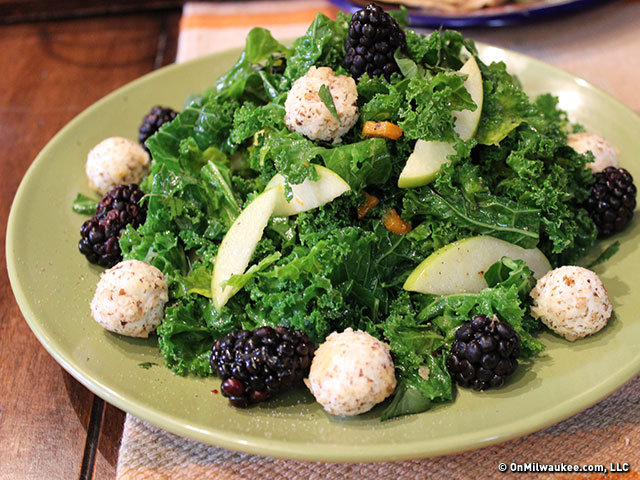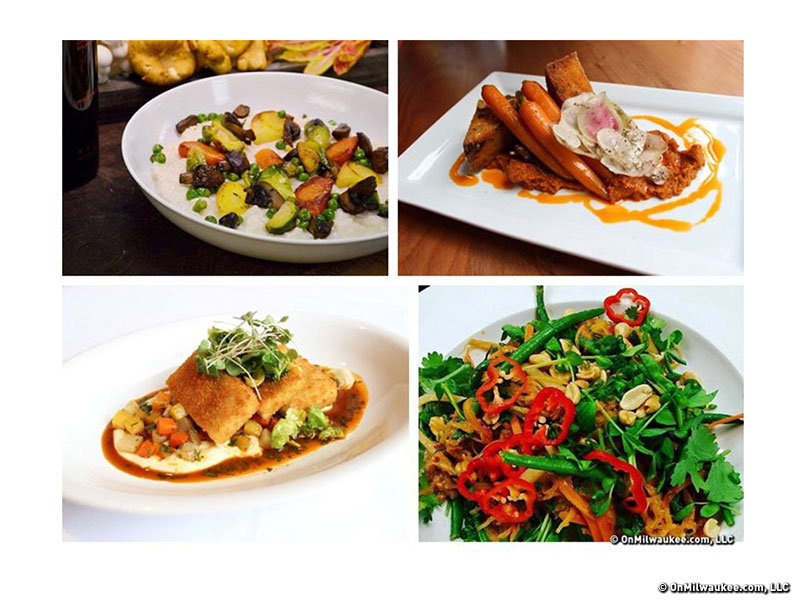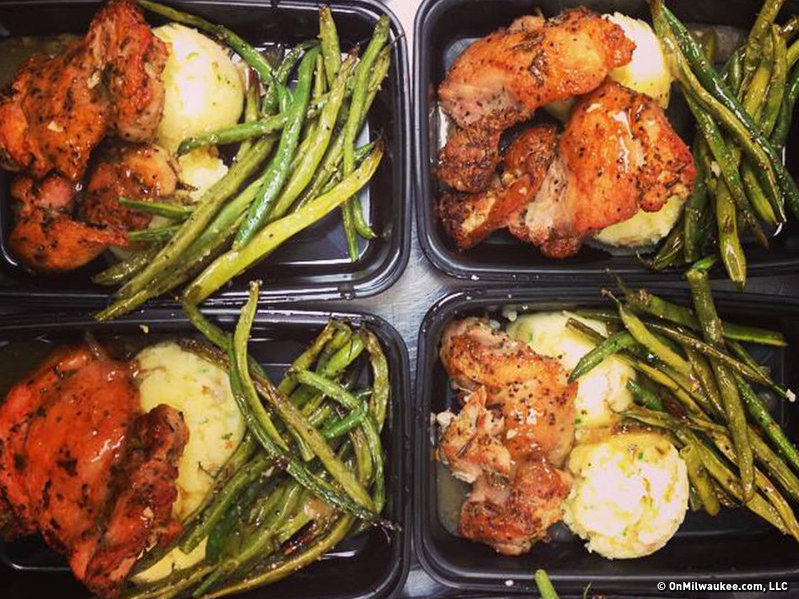New Year's celebrations are behind us, leaving only the resolutions to eat better and get fit. Don't worry, we're here to help. This week – Healthy Living Week, brought to you by The Milwaukee Y – we will focus on articles and information about exercise, eating right and staying healthy in a variety of ways.
In an age where technology brings more efficiency to our everyday tasks, it often seems that our lives are more fast-paced and hectic than ever. And for many of us, that means certain parts of our life take a back seat to the daily grind.
One of them is eating.
It’s a necessity that we provide our bodies with the nutrition it needs to keep up with our 21st Century lifestyles. But, if you’re like so many others, the prospect of getting a healthy meal on the table seven days a week is a near impossible task.
We feel your pain. So, in the spirit of Health Week, we reached out to a number of nutrition professionals to solicit their advice about how to make 2016 a more healthful year.
Follow the trends
You might think that food trends are to blame for some of the bad eating habits folks have developed over the years. And it’s true, at least in part. The bacon craze gave us all excuses to eat more fatty pork products. Dieting trends like Atkins led some to load up on cheese, eggs and steak. And even the low-fat diet trends of the past twenty years have put us at the mercy of marketers who encourage us to eat things like "100 calorie snack packs" of cookies.
But, not all food trends are detrimental to our health.
"The one trend I am most excited about is the growing access to locally grown foods through Farmers Markets," says Barb Heinen, HNC and practitioner at JoyfulEats.com.. "They are popping up across the country. It’s possible to eat local produce nearly all year as farmers explore ways to extend their growing season. Locally, we have Milwaukee County Winter Farmers Market providing produce and farm products throughout the winter months. I love them because they not only provide healthy foods, they also build community and strengthen the local economy. All of these boost wellness."

Jennifer Casey, a trained RDN who currently works as development director for the Fondy Food Center, agrees. And she says the local food movement is a dietary trend that’s significantly impacting peoples’ health.
"There are more farmers markets than ever, more good food restaurants than ever, more community gardens than ever," she explains. "And that represents a significant increase in the consumption of fresh produce, heirloom grains and beans, and pastured animal products. The food environment is shifting to be more supportive of more people’s health. It’s becoming more equitable as well – over 6,200 farmers markets across the country now accept SNAP and the latest farm bill included 100 million dollars to create projects that incentivize the purchase of locally grown fruits and vegetables at farmers markets and the like!"
And, as it turns out, plenty of people are heeding the call to eat healthier food.
"From the phone calls, clients and customers that I interact with there is a definite trend toward eating real food – organic, unprocessed, unadulterated clean food not grown or treated with pesticides, preservatives or the like," says Judy Mayer, DTR, nutritionist at Outpost Natural Foods Cooperative. "It’s a road to good health. There is so much disease as a direct result of the food we eat. If we can do one thing to overcome what we’ve done to our bodies and to regain good health it would be to start eating healthy, organic food."
In fact, the sheer access to information about food and wellness has increased.
"There are a plethora of healthy eating and wellness modalities that are popular right now," says Rachel Wilberding currently earning her Master of Science in Human Nutrition and Functional Medicine from the University of Western States. "Diets like Paleo and Whole30, and even gluten free diets are all raising the awareness of all of us about the foods we’re eating. With so many popular diets, and so many armchair wellness experts out there, it can be daunting to discern fact from fiction and know what’s best for you. The best first step? Start eating more vegetables and fruits, and less salty, sugary, and processed foods. The more you pay attention, the more you’re likely to choose healthy foods… even if you choose not to subscribe to any of the ‘it’ diets of the moment."
Overall, there seems to be a shift in the number of people who are paying attention to the foods they’re eating.
"Over the past 10 years, people have been more conscious about the source of their food and I am happy that trend seems to be here to stay," says Julie Haase, RDN and Deputy Clinical Nutrition Program Manager at the Milwaukee VA Medical Center. "I see people are seeking out less-processed foods and being more interested in cooking at home than they have been in years past. The majority of sodium in the American diet comes from processed foods, so by seeking out foods with minimal processing, people are decreasing their sodium intake."
Eat more vegetables
One of the themes that flowed through the advice from every nutrition professional we consulted seemed to focus on the importance of getting more greens (and reds and yellows and oranges) into our diets.
"The diet and wellness world is awash with diets and eating plans promising the fountain of youth, boundless energy, and a shrinking waistline. But here’s a secret: the single most important part of all those diet plans, and the common theme among them is ‘Eat more vegetables!’" says Wilberding. "If you can only make one change to your diet to help you look, feel, and perform your best, aim to eat 6 or more cups of vegetables and fruit every day. The more different colors, the better."
In addition to boosting your consumption of vitamins, minerals and antioxidants, an added benefit, Wilberding notes, is a reduction in your cravings for sweets and junk food.

If you’re dining out, Wilberding recommends choosing an entree that’s served with lots of vegetables. And "...when you can, substitute a side salad or sautéed veggies for fries or other starches. If you’re choosing alcohol with your meal, be sure you’re drinking at least one glass of water for every alcoholic beverage."
Casey agrees, noting that you can always order extra vegetables.
"Double that side of spinach or order a salad as a main course," Casey notes. "Or ask for a side serving of the braised fennel you noticed on a main dish you didn’t order."
Mayer suggests you bypass the bread basket in favor of extra vegetables. And, she notes, "Be aware of portions. Large portions do not give you permission to eat more than you should. You can always share."
Cook more often
Another common theme in the advice from each of the nutritionists was the idea of getting back to cooking more often at home.
"When you’re cooking from scratch, you are empowered," says Heinen. "You are taking control of what is in your food and what goes into your body. This may mean realigning how you use your time. However, it doesn’t need to be complicated. There are many ways to ensure that meals are ready when it’s time to eat. My work with clients always includes food prep strategies, simple recipes and cooking techniques to make the transition to cooking from scratch easy."

But, it’s often not practical to eat every meal at home. When you do dine out, Heinen suggests looking for restaurants that source their ingredients locally.
"When chefs are passionate about building relationships with local farmers, it tends to pay off in health benefits for diners," she says. "We are fortunate in Milwaukee to have many great restaurants that use local ingredients and cook from scratch, rather than using shortcuts."
Haase adds that, in an ideal world, dining out should be the exception, rather than the rule.
"It’s not something that we should do every day or even several times a week," she explains. "If you do need to dine out more frequently, the first thing I suggest is just to limit portion sizes. You can ask for a smaller serving or just not eat everything you were served. You can take it a step further by limiting foods that are breaded, battered, fried, smothered or include some sort of cream sauce. Also, be conscious of your beverages - drinks can easily double the calories of a meal."
Practice mindfulness
Turning your focus to eating more real, healthful food is a common first step recommended by all the nutritionists we consulted. But, they also recommended a number of other techniques to increase health and wellness. One of the biggest themes running through their advice was maintaining a sense of mindfulness.
"Ditch the diets," says Heinen. "They don’t work. They create more stress and stress does all kinds of nasty things to our bodies. As we add real foods into our lives, we start to quiet down the noise or interference that gets in the way of listening to our bodies. Rather than vilifying foods or food groups, let the focus be on working with your body and its innate wisdom. Practice mindful eating. This trend or awareness is starting to grow, and it’s a great thing. Learn to love and honor your body in gentle ways. We are born knowing what our bodies need, rebuild that communication through the practice of mindfulness."
Listening to your body takes many forms. Taking the time to eat slowly, and deliberately, is a piece of advice Haase says she gives to many of her clients.
"I talk to many people who are not necessarily eating ‘bad’ foods, but just eating too much in general," she says. "In our society, we are always in a hurry or we eat mindlessly in front of a screen, inhaling our food without even thinking about it. But, it takes about 20 minutes for the ‘thanks for feeding me!’ message to get from your stomach to your brain. If we eat a meal in 10 minutes, we aren't even giving that signal a chance to be effective. Take time to chew your food & think about the flavors - try to identify the ingredients. Put your fork down. Take a sip of water. Have a conversation with someone. Enjoy your food."
Heinen agrees.
"So many people eat on auto-pilot," she notes. "They are so busy that they don’t take the time to cook. It feels easier to do fast food or convenience foods. The toll that takes on health is huge. Unfortunately, we don’t realize it until the imbalances in our bodies are so great that we have health issues like obesity,metabolic syndrome, diabetes, heart disease, or an autoimmune disease. If a person’s priority is health, then creating time to cook from scratch and practice mindful eating ensure that actions are aligned with that priority."
As a passionate champion of the local dining scene, Lori has reimagined the restaurant critic's role into that of a trusted dining concierge, guiding food lovers to delightful culinary discoveries and memorable experiences.
Lori is an avid cook whose accrual of condiments and spices is rivaled only by her cookbook collection. Her passion for the culinary industry was birthed while balancing A&W root beer mugs as a teenage carhop, fed by insatiable curiosity and fueled by the people whose stories entwine with every dish. Lori is the author of two books: the "Wisconsin Field to Fork" cookbook and "Milwaukee Food". Her work has garnered journalism awards from entities including the Milwaukee Press Club. In 2024, Lori was honored with a "Top 20 Women in Hospitality to Watch" award by the Wisconsin Restaurant Association.
When she’s not eating, photographing food, writing or planning for TV and radio spots, you’ll find Lori seeking out adventures with her husband Paul, traveling, cooking, reading, learning, snuggling with her cats and looking for ways to make a difference.






